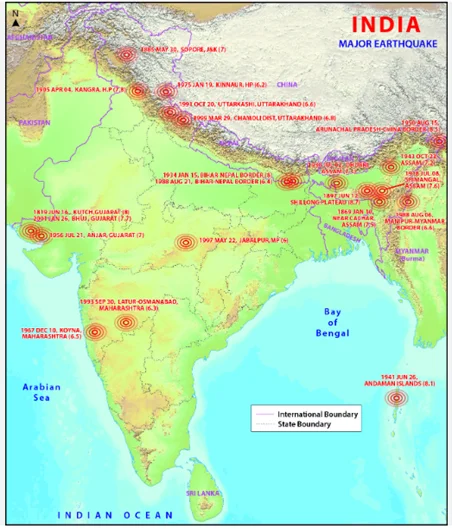Answer:
| Approach:
Introduction
- Start your answer with tectonic plates in India.
Body
- Reasons for the Increased Frequency of Earthquakes.
- Recent Major Earthquakes in the Region.
- Gaps in India’s Preparedness for Mitigating the Impact of Earthquakes.
- Mechanisms for Preparedness to Reduce the Risk During Earthquakes.
Conclusion
- Summary of the answer with futuristic approach.
|
Introduction:
India’s location at the boundary of two converging tectonic plates makes it a hotspot for earthquakes, with over 60% of the country’s area vulnerable to seismic activity. Despite the significant threat, mitigation measures in India are inadequate.
Body:
Reasons for the Increased Frequency of Earthquakes:
- The increased frequency of earthquakes in the Indian subcontinent can be attributed to various factors.
- Primary reasons are plate tectonics and subduction zones, which cause seismic activity in the region.
- Anthropogenic activities such as mining and dam building that can trigger earthquakes.
Recent Major Earthquakes in the Region:
- The Indian subcontinent has witnessed several major earthquakes in recent years, including the 2015 Nepal earthquake, the 2001 Bhuj earthquake and the 2004 Indian Ocean earthquake and tsunami.
- These earthquakes caused widespread damage to infrastructure and loss of life, particularly in India’s coastal regions.

Gaps in India’s Preparedness for Mitigating the Impact of Earthquakes:
- There are several gaps in the country’s ability to mitigate the impact of earthquakes, including the lack of building codes and seismic-resistant structures.
- The absence of a dedicated agency for earthquake response and management, limited public awareness and education on earthquake preparedness, and insufficient resources and funding for earthquake mitigation and response.
Mechanisms for Preparedness to Reduce the Risk During Earthquakes: To reduce the impact of earthquakes, India needs to adopt a multi-faceted approach.
- This includes the development of earthquake-resistant building codes and retrofitting of existing structures.
- The establishment of a dedicated agency for earthquake management and response, conducting regular earthquake drills and awareness campaigns, and investment in research and development of innovative technologies for earthquake mitigation.
Conclusion:
The increasing frequency of earthquakes in the Indian subcontinent highlights the urgent need for India to prioritize earthquake preparedness and mitigation efforts. By adopting a multi-faceted approach and investing in earthquake preparedness, India can save lives, reduce damage, and promote long-term economic stability. It is crucial for India to take immediate action to reduce the impact of earthquakes and ensure the safety and well-being of its citizens.
